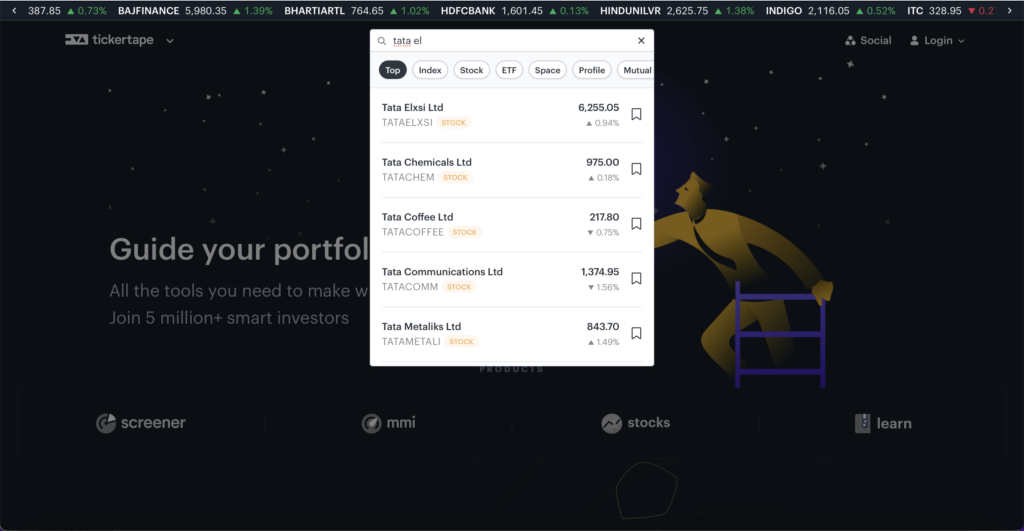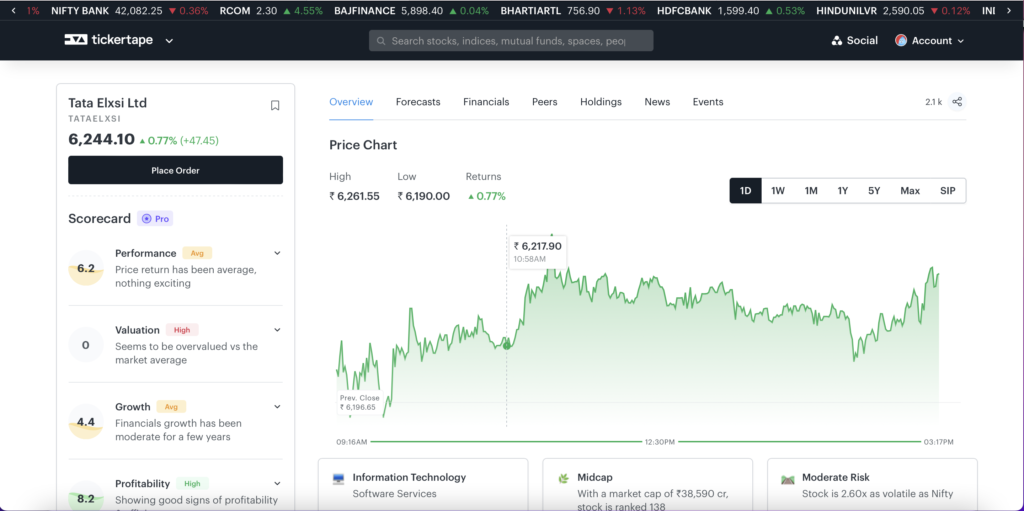Last Updated on Mar 1, 2024 by Harshit Singh
The semiconductor industry has come into the limelight in recent years. This is especially true since the advent of the pandemic – when the demand for semiconductors increased immensely, but supply constraints resulted in a global shortage. However, because of their crucial application in electronic devices, semiconductor companies continue to enjoy popularity. In this article, let’s take a look at the industry overview, semiconductor stocks in India, and why the sector is likely to be a lucrative investment option.
Table of Contents
Best semiconductor stocks in India 2024
| Name | Sub-Sector | Market Cap (Rs. in cr.) | Close Price (Rs.) | PE Ratio | 5Y CAGR (%) | 5Y Avg EBITDA Margin (%) | 5Y Avg Return on Investment (%) |
| HCL Technologies Ltd | IT Services & Consulting | 412,598.06 | 1,576.40 | 27.78 | 27.21 | 25.01 | 20.26 |
| Vedanta Ltd | Metals – Diversified | 93,669.85 | 262.55 | 8.86 | 6.29 | 25.28 | 10.36 |
| Tata Elxsi Ltd | Software Services | 51,039.90 | 7,768.45 | 67.59 | 52.78 | 29.36 | 29.26 |
| Dixon Technologies (India) Ltd | Home Electronics & Appliances | 35,013.75 | 5,920.10 | 137.03 | 67.17 | 4.50 | 18.84 |
| Moschip Technologies Ltd | Software Services | 1,856.07 | 100.83 | 299.37 | 36.34 | -1.52 | -5.97 |
| MIC Electronics Ltd | Electrical Components & Equipments | 749.60 | 34.20 | 2,776.28 | -169.57 | ||
| Ruttonsha International Rectifier Ltd | Electronic Equipments | 575.36 | 827.00 | 96.38 | 82.32 | 12.90 | 9.23 |
| ASM Technologies Ltd | IT Services & Consulting | 500.01 | 460.35 | 52.36 | 54.44 | 11.75 | 11.36 |
| Solex Energy Ltd | Industrial Machinery | 465.80 | 590.50 | 171.25 | 80.29 | 5.46 | 12.65 |
| SPEL Semiconductor Ltd | Electronic Equipments | 344.22 | 73.22 | -111.40 | 54.53 | -10.32 | -5.46 |
| Surana Telecom and Power Ltd | Cables | 219.93 | 16.15 | 50.91 | 30.91 | 66.60 | 6.52 |
Note: The list of Indian semiconductor companies and their information provided here is as of 24th January 2024 and is not sorted based on any parameter.
HCL Technologies Ltd
Founded in 1976, HCL Technologies is a multinational IT and consulting company. It is engaged in providing a range of software development services, business process outsourcing services and information technology infrastructure services. The company has an investment of $825-mn in the country for an Outsourced Semiconductor Assembly and Test (OSAT) plant at Sanand in Gujarat. The cumulative investment in the project is $2.75 bn.
- The market capitalisation of HCL Technologies is Rs. 4,12,598.06 cr. The stock’s 5-yr CAGR is 27.21%.
- The stock is 2.11x as volatile as Nifty.
- As per the Tickertape Scorecard, the stock is overpriced but shows good signs of profitability and efficiency. The stock has no red flags.
Click here to learn more about the stock’s financial performance.
Vedanta Ltd
Founded in 1965, Vedanta is a global diversified natural resource company operating across segments: aluminium, copper, power, iron ore, lead, silver, zinc, oil, gas, etc. The company has finalised a technology partnership with Taiwanese firm Innolux and is also close to finalizing a partnership for semiconductor manufacturing.
- The market capitalisation of the company is Rs. 93,669.85 cr. The stock’s 5-yr CAGR is 6.29%.
- The stock is 2.93x as volatile as Nifty.
- As per the Tickertape Scorecard, the stock is underpriced. The stock has a moderate number of red flags.
Click here to learn more about the red flags present in the stock.
Tata Elxsi Ltd
Founded in 1989, Tata Elxsi is involved in the design and development of computer software and hardware. The company operates in two segments: system integration and support and software development and services.
- The market capitalisation of Tata Elxsi is Rs. 51,039.90 cr. The stock’s 5-yr CAGR is 52.78%.
- The stock is 2.09x as volatile as Nifty.
- As per the Tickertape Scorecard, the stock has a profitability score of 8.2 out of 10, showing good signs of profitability and efficiency. The stock is overpriced and has no red flags.
Learn more about the stock’s performance here.
Dixon Technologies (India) Ltd
Dixon Technologies is a multinational contract manufacturer of electronics like washing machines, televisions, smartphones, LED bulbs, etc. The company was founded in 1993 as Weston Utilities Ltd.
- The market capitalisation of Dixon Technologies is Rs. 35,013.75 cr. The stock’s 5-yr CAGR is 67.17%.
- The stock is 3.67x as volatile as Nifty.
- As per the Tickertape Scorecard, the stock has good profitability and performance scores. It is overvalued and overpriced and has no red flags.
Click here to find out future predictions for the stock’s financial performance.
Moschip Technologies Ltd
Founded in 1999, Moschip Technologies is a semiconductor and system design services company, which focuses on mixed-signal IP, Turnkey ASICs, IoT solutions, semiconductor and product engineering catering to several sectors like automotive, medical, networking and telecommunications, consumer electronics, aerospace and defence.
- The market capitalisation of Moschip Technologies is Rs. 1,856.07 cr. The stock’s 5-yr CAGR is 36.34%.
- The stock is 4.47x as volatile as Nifty.
- As per the Tickertape Scorecard, the stock has no red flags. It has an average performance score and lags behind financial growth.
Check the stock’s balance sheet and find deeper insights here.
MIC Electronics Ltd
Founded in 1988, MIC Electronics is a manufacturer of electric lighting equipment. The market capitalisation of the company is Rs. 749.60 cr.
- The stock is 5.25x as volatile as Nifty.
- As per the Tickertape Scorecard, the stock has an average growth and profitability score. There are no red flags in the stocks.
Click here to learn more about the stock.
Ruttonsha International Rectifier Ltd
Founded in 1969, Ruttonsha International Rectifier is a manufacturer of power semiconductors and has over five decades of association with International Rectifier, USA.
- The market capitalisation of the company is Rs. 575.36 cr. The stock’s 5-yr CAGR is 82.32%.
- The stock is 5.04x as volatile as Nifty.
- As per the Tickertape Scorecard, the stock has a good performance score, 7.6 out of 10. It has a good profitability score of 7.1 out of 10, which shows good signs of profitability and efficiency. There are no red flags in the stock. However, the stock is overvalued.
Check the stock’s balance sheet and find deeper insights here.
ASM Technologies Ltd
Founded in 1992, ASM Technologies offers business and technology consulting, application maintenance, enterprise solutions, product support, etc.
- The market capitalisation of the company is Rs. 500.01 cr. The stock’s 5-yr CAGR is 54.44%.
- The stock is 4.31x as volatile as Nifty.
- As per the Tickertape Scorecard, the profitability score is 7 out of 10, showing good signs of profitability and efficiency. There are no red flags in the stock.
To learn more about the stock and compare it with its peers, click here.
Solex Energy Ltd
Founded in 1998, Solex Energy manufactures solar panels, solar lighting systems, solar water pumping products and water heater products.
- The market capitalisation of Solex Energy Ltd is Rs. 465.80 cr. The stock’s 5-yr CAGR is 80.29%.
- The stock is 5.60x as volatile as Nifty.
- As per the Tickertape Scorecard, the stock is overvalued and lags behind in financial growth. It also has a moderate number of red flags. However, the stock has a good profitability score of 6.9 out of 10, which shows good signs of profitability and efficiency.
Explore more about the stock’s financials here.
SPEL Semiconductor Ltd
Founded in 1984, SPEL Semiconductors is India’s first Semiconductor IC assembly and test facility provider.
- The market capitalisation of the company is Rs. 344.22 cr. The stock’s 5-yr CAGR is 54.53%.
- The stock is 5.48x as volatile as Nifty.
- As per the Tickertape Scorecard, the stock is overvalued and lags behind in financial growth. It has average performance and profitability score. The stock has a moderate number of red flags.
Click here to learn more about the red flags present in the stock.
Surana Telecom and Power Ltd
Founded in 1989, Surana Telecom and Power manufactures petroleum jelly, high-tension power cables, and telecom products such as jointing kits. They are also engaged in the generation of solar energy and trading of solar modules.
- The market capitalisation of Surana Telecom and Power is Rs. 219.93 cr. The stock’s 5-yr CAGR is 30.91%.
- The stock is 5.47x as volatile as Nifty.
- As per the Tickertape Scorecard, the stock is overvalued and lags behind in financial growth. The stock has a good profitability score of 7.8 out of 10, which shows good signs of profitability and efficiency. There are no red flags in the stock.
Find more information about the stock and its financial performance here.
What is a semiconductor?
A semiconductor is a tiny chip that gives life to electronic devices. It manages the flow of electricity in electronic products like smartphones, computers, electric vehicles, medical equipment and gaming hardware. Semiconductors are used in consumer electronics like ACs, rice cookers, CPUs, and commercial devices such as ATMs, trains, and other infrastructures.
These are also used in Electric Vehicles (EVs). And you need not one, but hundreds of chips in the making of a standard EV. The advancement in Artificial Intelligence (AI), the Internet of Things (IoT), and other forms of technology have shot semiconductor demand in the world. However, the supply chain constraints and global shortage have put the semiconductor industry under immense stress lately.
What are semiconductor stocks?
Semiconductor stocks represent shares in companies that design, manufacture, and distribute semiconductors or chips. These companies are integral to the electronics industry, producing tiny chips that power a wide range of devices, from smartphones and computers to electric vehicles and medical equipment.
Investing in semiconductor stocks allows individuals to participate in the growth and advancements of the technology sector. Notable semiconductor companies include Intel, AMD, NVIDIA, and Qualcomm. Investors often track these stocks to gauge trends in technology and the overall health of the electronics market.
Impact of semiconductor shortage
Supply chain constraints and a global shortage have made the semiconductor market quite volatile for 2 yrs now. Experts predict it to go on till early 2024. The supply chain disruptions in the semiconductor space have impacted over 169 industries across countries, including India. As per Deloitte, the chip shortage over the last 2 yrs has resulted in a revenue loss of over $500 bn.
What explains the global semiconductor shortage?
As per S&P Global Engineering Solutions, semiconductor shortage is not new. It is cyclical. Historically, the periods of shortages have lasted 6 months to a year, but the current one has deviated from that trend. A few reasons for this are:
Unforeseen events before and during the pandemic
In early 2019, a fire in Ukraine impacted the production of the packaging material of semiconductors. In March 2021, a fire in Japan’s Renesas fabrication (fabs) facility forced the microcontroller production to go offline for 3 months. Most of its chips supported the automotive industry. At the same time, a cargo ship stuck in the Suez Canal blocked the passage for over a week, impacting the chip delivery in transit.
In October 2021, staffing shortages resulted in 77 ships getting bottlenecked outside the Los Angeles and Long Beach docks. In the following year, in February, an ice storm in Texas resulted in a power outage and forced Samsung, NXP, and Infineon fabs to halt production.
Each of these events cumulatively played out in disrupting the supply of semiconductors and causing a global shortage.
The COVID pandemic
The challenges only escalated in 2020 when the pandemic-triggered lockdowns across the globe forced semiconductor manufacturing companies to stop production. The auto sector, which accounted for most of the demand, cut down its orders, anticipating a drastic fall in car sales.
But with businesses going through digital transformation, the demand for chips shot from newer products like home IT equipment, smartphones, and recreational products like PlayStations and VR headsets. This meant that the semiconductor market had to transition from producing lower-cost car chips to expensive processors for consumer goods.
With a huge gap in demand and supply, things got messy. And by the time economies started opening up, the demand from the auto industry added to the existing orders of consumer goods. Thus began the automotive chip shortage.
Geopolitical issues between the US and China
Southeast Asia, China, and Taiwan have been the hub for chip factories. However, the geopolitics issues and trade war between China and the US made things hard. China’s tech crackdown and its challenge with Taiwan worsened things.
New semiconductor factory construction
To bridge the immense gap in demand and supply of semiconductor chips, countries across the globe commissioned new fab units. Chip manufacturers and foundries have started planning for 29 new semiconductor factories across China, Taiwan, the US, Japan, and Korea. It takes ~3 yrs for fabs to become operational. While the industry expects 200 fabs to become operational by 2026, the construction of fabs has its own set of challenges due to a shortage of materials and labour.
Overview of the semiconductor industry in India
Currently, India imports 100% of its semiconductors, majorly from Taiwan, China, Korea, and Vietnam. This results in a huge import value of ~$24 bn. The Ministry of Electronics and Information Technology estimates that India’s semiconductor market will grow to $63 bn, four times the current market, by 2026. And with the 5G rollout around the corner, the demand for semiconductors may break the ceiling.
On January 18, 2024, the government approved a deal between India and the European Union. The goal is to work together on semiconductor research, innovation, and technology development. This partnership aims to make the semiconductor supply chain stronger in both India and the EU. It covers cooperation in wide areas covering research and innovation, talent development, partnerships and exchange of market information.
How is India planning to address the global semiconductor shortage?
The global semiconductor shortage and supply constraints have impacted various sectors of the Indian economy. To be better prepared to meet the demand for chips, the government has taken several measures discussed below.
- Funds sanctioned under the PLI scheme
The government has earmarked Rs. 76,000 cr. in the Production-linked Incentive (PLI) scheme for semiconductor and display manufacturing. Of the sanction amount, Rs. 2.3 lakh cr. is reserved to encourage the domestic manufacturing of semiconductors.
The objective is to help create a semiconductor ecosystem in India. The scheme is likely to support the opening of ~20 semiconductor manufacturing in India in the coming 6 yrs. Additionally, design, components, and display fabs are expected to be started. The scheme will also offer much-needed financial assistance to semiconductor companies. The subsidies offered under the scheme will reduce the chip manufacturing companies’ production costs. This would encourage them to amplify their production to maximise their profits.
Apart from helping the semiconductor companies, the PLI scheme is also expected to create employment opportunities in the country. As per the government, ~35,000 specialised and 1 lakh indirect job opportunities will be created. Not only this, but the scheme could also generate investments of ~Rs 1.7 lakh cr.
- Semicon India Program
To reduce its import dependency and help solve the global chip crisis, the Indian government also announced a ‘Semicon India Program’ in December last year. The program welcomes semiconductor companies to build and operate their plants. The government has offered financial support of up to 50% of a project’s cost to eligible manufacturers.
The government accepted proposals from international chip manufacturers, and companies like TSMC, Foxconn, Fujitsu, Intel, and AMD had shown interest. Tata Group had also announced plans to invest up to US $300 mn on a semiconductor assembly and test unit in South India. In December last year, Vedanta announced to invest ~US $15 bn on a semiconductor plant. And recently, it cheered the market by announcing progress on the front.
Why invest in top semiconductor stocks in India?
As you may have noticed, the demand for semiconductors is only going to increase in the years to come. And the government has taken several measures, such as sanctioning funds under the PLI scheme and announcing the Semicon India Program to make India a prominent hub for the manufacturing of semiconductors. Private companies, both domestic and international, have responded positively to this. Some of the examples are:
- Multinational mining company Vedanta announced a joint venture with Taiwanese-based Foxconn. It has also signed two Memorandum of Understanding (MoUs) with the Government of Gujarat to set up a semiconductor and related facilities in Ahmedabad.
- Tata Motors and Tejas Networks Ltd joined hands with Japan-based chipmaker Renesas Electronics Corp to design, develop, and manufacture Renesas’ semiconductor solutions for emerging markets, including India.
- Rajesh Exports is planning an investment of $3 bn to set up India’s first electronic display plant in Telangana. The company has also applied for the PLI scheme.
- Ruttonsha was the only entity to register for making compound semiconductors when the government invited bids for semiconductor fab units. The company was taken over by US-based Silicon Power Corporation in 2005, opening up doors to developmental and technological expertise.
- SPEL Semiconductor was the only one to register for semiconductor packaging under the PLI scheme.
The above instances make investing in the semiconductor shares a lucrative option, provided the plans and partnerships are executed well.
Things to consider before investing in the best semiconductor stocks in India
- Ensure that the company has displayed a consistent increase in its revenue growth. Moreover, it should also be able to translate sales into profits. Only then can it reinvest profits into research and operations to grow the business further.
- The company must have strong financials. Scan its income statement, balance sheet, cash flow statement, annual report, and other important documents to analyse the company’s past and current performance. This would indicate its prospects and guide you in making the right investment decision.
- Beware of the risks and developments in the semiconductor industry and within the company.
- Although the government is putting a lot of effort into making India a global hub for semiconductors, the ecosystem would need time to form, maintain, and grow. Initially, the companies would spend immense resources on research and operations, which would increase their costs and limit their profits. So it would be best to invest with a long-term horizon in mind.
- Do not follow recommendations, tips, and unsolicited advice blindly. Consult a financial advisor if need be, but ensure to invest only after analysing the semiconductor stocks thoroughly.
How to analyse a semiconductor stock in India?
You can use Tickertape to analyse any stock in the NSE. Follow the steps below to analyse aa stock on Tickertape.
- Log in Tickertape
- Enter the name of the stock in the search bar

- You’ll get all the information regarding a stock – its current price, 1W returns, 3M returns, 1Y returns, and 5Y returns along with the key metrics of the stock. Not just that, you can go through the financials of the company in the ‘financials’ tab.

- You can also check the Scorecard, which provides scores for performance, valuation, growth and profitability of a stock.
FAQs
What can replace semiconductors?
What is the semiconductor stocks list?
What are the semiconductor stocks in NSE?
– Tata Elxsi Ltd
– ASM Technologies Ltd
– Dixon Technologies (India) Ltd
– SPEL Semiconductor Ltd
– Moschip Technologies Ltd
– Ruttonsha International Rectifier Ltd
– HCL Technologies Ltd
– MIC Electronics Ltd
– Surana Telecom and Power Ltd
– Vedanta Ltd
– Solex Energy Ltd
Who should invest in semiconductor stocks in India?
What are the semiconductor penny stocks in India?
- Best Fundamentally Strong Penny Stocks (2024) - Apr 10, 2024
- Best Liquor Stocks in 2024 - Apr 4, 2024
- All Pharma Penny Stocks in India: Pharma Shares Below Rs. 50 - Apr 2, 2024






